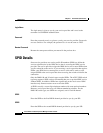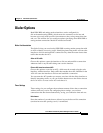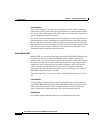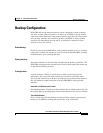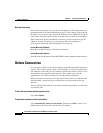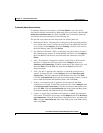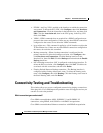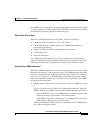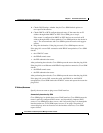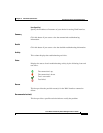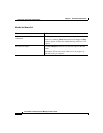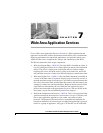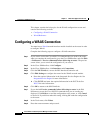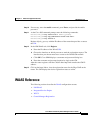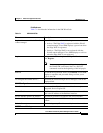
Chapter 6 Edit Interface/Connection
Connectivity Testing and Troubleshooting
6-64
Cisco Router and Security Device Manager 2.5 User’s Guide
OL-4015-12
2. Checks DNS Settings, whether they be Cisco SDM default options or
user-specified hostnames.
3. Checks DHCP or IPCP configuration and status. If the router has an IP
address through either DHCP or IPCP Cisco SDM goes to step 4.
If the router is configured for DHCP or IPCP but has not received an IP
address through either of these methods, Cisco SDM performs the checks in
step 1. The test terminates and Cisco SDM reports the results and suggests
actions.
4. Pings the destination. If the ping succeeds, Cisco SDM reports success.
If the ping fails on an xDSL connection with PPPoE encapsulation, Cisco SDM
checks:
• the ATM PVC status
• the PPPoE tunnel status
• the PPP authentication status
After performing these checks, Cisco SDM reports the reason that the ping failed.
If the ping fails on an Ethernet with PPPoE encapsulation connection, Cisco SDM
checks:
• the PPPoE tunnel status
• the PPP authentication status
After performing these checks, Cisco SDM reports the reason that the ping failed.
If the ping fails on an xDSL connection with AAL5SNAP or AAL5MUX
encapsulation, Cisco SDM checks the ATM PVC status and reports the reason the
ping failed.
IP Address/Hostname
Specify the server name to ping to test WAN interface.
Automatically determined by SDM
Cisco SDM pings its default host to test WAN interface. Cisco SDM detects the
router's statically configured DNS servers, and dynamically imported DNS
servers. Cisco SDM pings these servers, and if successful pings exit through the
interface under test, Cisco SDM reports success. If no pings succeeded, or
successful pings were not found to exit the interface under test, Cisco SDM
reports failure.



